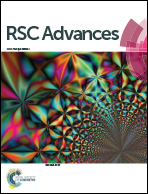Synthesis and characterization of Fe3O4@TSC nanocomposite: highly efficient removal of toxic metal ions from aqueous medium†
Abstract
In the present study, trisodium citrate (TSC) modified magnetite (Fe3O4) nanocomposite was synthesized and characterized using various analytical techniques. The transmission electron microscope images show that the Fe3O4@TSC nanoparticles are well dispersed due to the presence of the TSC coating on Fe3O4, and the particles sizes are in the range of 5–10 nm. The SBET and the total pore volume of Fe3O4@TSC are 245.42 m2 g−1 and 0.368 cm3 g−1, respectively. The saturation magnetization values of Fe3O4 and Fe3O4@TSC are 78.4 and 55.4 emu g−1, respectively. The Fe3O4@TSC is a magnetic adsorbent and was used for the removal of Cr3+ and Co2+ metal ions from aqueous medium. The adsorption of both metal ions onto Fe3O4@TSC is rapid and efficient. The adsorption process is performed at diverse temperatures and the outcomes are investigated kinetically. The results show that adsorption was exothermic and followed the pseudo-second-order kinetic model. Isotherm modelling reveals that the Langmuir equation described the adsorption of both metal ions. Moreover, the loaded Fe3O4@TSC could be recovered easily from aqueous solution by magnetic separation and regenerated by simply washing with 0.1 M HCl solution. Consequently, Fe3O4@TSC nanocomposite could be utilized as an efficient and recyclable adsorbent for the removal of toxic metal ions from aqueous solution.


 Please wait while we load your content...
Please wait while we load your content...